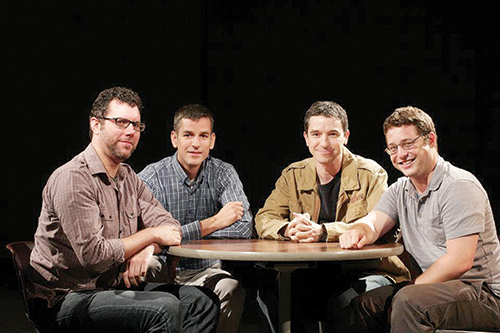
The webisodes, which used to be 10 minutes long, are now a full 20–30 minutes because of viewer feedback—people liked the show, they just didn’t think it was long enough.
Season one of Film versus Film was based in Philadelphia. In it, Morrow, along with film teacher and media activist David Cooper Moore, film professor Chris Cagle and film critic Matt Prigge, have analytical and critical conversations about film.
The topics range from films that they feel have terrible screenplays to films that they think should be remade.
“When you’re doing a discussion-based series like this, you have to find the right mix of people to ensure that the conversation is intelligent and lively,” Morrow said. “The only way for a show to work is to bring up a film that the other three know what you’re talking about.”
Morrow’s focus is genre films in recent decades, while Cagle focuses on classic Hollywood films, Prigge focuses on art films and Moore focuses on films that have made an impact on pop culture.
“It’s cool when you see a crossing point with a film and what each one likes about it the most,” said Matt Boyle, director of Film versus Film and a freelance filmmaker.
Morrow’s next plan is to film a second season based in Portland. His two biggest challenges are finding networks to broadcast the show to a Portland audience and finding a diverse group of panelists who have an overall encyclopedic knowledge of film, he said.
“It’s hard to find people who have seen everything because there aren’t many of us,” Morrow said.
Boyle and Morrow both came up with the topic “best Philadelphia movie” in season one. They would like to have a “best Portland movie” episode in the future season.
Boyle also edited the episodes and composed the show’s score. He pictured the show being laid-back and added a jazz-like score to match that tone.
“I just pictured it kind of jazzy,” Boyle said.
The show was produced with assistants from Temple University in Philadelphia, the school where Morrow taught. It was shot in one of the TV studios on Temple University’s campus.
Shooting season one took only three days. Boyle filmed Morrow and the other panelists for three hours each day, with small breaks between each hour. The most difficult process of production was editing.
“We shoot with five cameras running simultaneously,” Morrow said. “We collect a lot of footage and when you watch an episode that’s seven minutes long, that seven minutes might have been extracted from 30 or 40 minutes of footage.”
The four panelists often go off on tangents during filming, which are then briefly featured in the seven-minute episodes. Boyle carefully edits the episodes to make them appear well-paced and on-topic.
Morrow chose to make Film versus Film a Web-based series because it allows the audience to interact with the commentators and participate in the discussions via feedback on sites such as Facebook, Twitter, YouTube and Tumblr.
“That’s why we named the episodes [with] questions,” Morrow said. “It invites the viewer to participate in the discussion…people would disagree with us [in the YouTube, Twitter or Facebook comments], come up with their own answers [and] call us idiots or call us nerds, which we are.”
Lisa Molinelli, PSU’s interim education/instruction librarian, works as the social media producer of Film versus Film. She posts videos and polls through Twitter and Facebook. She posts about films on Facebook, while keeping a more rapid conversation going on Twitter.
“Twitter tends to be very active in certain arenas, and I think film is one of those,”
Molinelli said.
Molinelli would also post episodes on Twitter at different times throughout the day to expose them to more people. She also reposted people’s tweets and thanked them for watching.
“I was trying to get people’s attention on Twitter by showing them [that] we’re out there, and what we’re interested in,” Molinelli said.
Morrow chose to focus more on content and classic movies rather than reviewing current movies because he felt not enough shows were doing so.
“Most of what I was seeing on TV and the Web was reviews [shows] like Siskel & Ebert, or behind-the-scenes stuff. There wasn’t a lot of talk about older movies and content, and none surrounding these theoretical questions that we were asking each other,” he said.
Morrow and Boyle, along with the other panelists, worked to brainstorm topics for the episodes.
“We had anything from film festivals to the best and worst of Keanu Reeves,” Boyle said.
Morrow got the idea for Film versus Film from participating in long discussions about certain topics while socializing in pubs with the other panelists. They would have competitive conversations about certain topics, such as the most awkward nude scene on film.
“Someone would propose a topic like that while we were drinking, and we would talk about it for two hours,” Morrow said. “The conversations got very funny and I started to think [that] maybe there was an audience for a show like this.”

